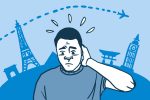Have you ever found yourself in a scary situation, heart pounding and out of breath? Almost like breathing has become harder? This is the fight, flight or freeze response. According to the WebMD article “What Does Fight, Flight, Freeze, Fawn Mean?”: “The fight response is your body’s way of facing any perceived threat aggressively. Flight means your body urges you to run from danger. Freeze is your body’s inability to move or act against a threat. Fawn is your body’s stress response to try to please someone to avoid conflict.”
The fight, flight or freeze response activates the sympathetic nervous system. Your arms and legs receive more oxygen, which prepares you for a battle or a quick getaway. However, your prefrontal cortex receives less oxygen, making it difficult to think coherently.
At the same time, the parasympathetic nervous system, which is activated by deep breathing and relaxation, tells the anxious part of your brain that you are safe and don’t need a fight, flight or freeze reaction. When you breathe deeply, more oxygen reaches the thinking part of your brain. By dealing with the bodily symptoms of the fight, flight or freeze response directly, you free up mental energy to deal with other factors that you may encounter.
It is incredible that our bodies have developed a multi-option survival mechanism, something that is also found in other animals. Someone can repel the threat or run, or even freeze to avoid danger. Contrary to popular belief, stressors are not only present in life-threatening situations but also in relatively relaxed scenarios, such as work, family and relationships.
How people react to a given stressor varies from person to person and is determined by how well one can handle stress. Preexisting mental illnesses also play a role in how easily triggered someone is by a stressor. Something as little as homework can trigger a child, yet the same assignment may not be powerful enough to trigger an adult. As humans, we react differently to things based on age, experience, mental well-being and more.
When you inhale deeply and exhale slowly and steadily, your parasympathetic nervous system receives a signal to relax. Long, deep breaths can also help to regulate stress reactions and lessen feelings of dread, anxiety and racing thoughts, as well as slow down your heartbeat and prevent shallow-chest breathing. How you react to stressors has a direct bearing on your physical, mental and emotional well-being. To relax your body by breathing, make sure that your abdomen (not just your chest) expands and fills with air when you breathe in and contracts and empties when you breathe out.
You may notice that when you experience stress or anxiety, your abdomen moves inward when you inhale and outward when you exhale. Such a breathing pattern is ineffective and should be changed so that you inhale while expanding the abdomen and exhale while contracting it. If you’re experiencing a stressor, take deep breaths for as long as you need. Many find that as little as three to five minutes is enough time to become grounded. In addition to their ability to regulate your nervous system, breathing techniques may also ease your worries, as your focus is taken away from stressors and directed at counting and timing your breaths.
In the Scientific American article “Proper Breathing Brings Better Life,” author Christopher Andre explains, “When you are feeling frightened, in pain, or tense and uncomfortable, breathing speeds up and becomes shallower. The sympathetic nervous system, which is responsible for the body’s various reactions to stress, is now activated.” Your body reacts to the increased levels of physical and emotional stress that you are experiencing by accelerating your breathing.
One of the most popular ways to address various stressors is through yoga. If you have practiced any type of yoga, you will notice that breathing is the focus of most exercises. Breathing and meditation are crucial components in most forms of yoga and often go hand in hand, sharing the ultimate goal to find some sort of Zen and to instill peace in both your body and your mind.
If you are having a bad day, a “silly” breathing technique you once read or heard about might be the last thing on your mind. However, if you start practicing breathing techniques before reaching the peak of your bad day, you can prevent the negative emotions from escalating. Try it out! In fact, you don’t even have to wait until you are stressed to practice; you can start here and now. Breathe in for five seconds, hold for another five seconds, and then breathe out for five seconds. Afterward, you may notice a lot of tension release from your muscles, your shoulders relax and your tongue drop from the roof of your mouth.
The best thing about breathing techniques is that you can do them wherever you feel the most comfortable. Breathing takes minimal effort and the outcome is extremely positive, as “up to 70% of the toxins that your body retains are meant to be expelled through the breathing process.” Stress can not only lead to mental illness but can also cause some unwanted health complications, which is why it’s important to take care of your mind, body and soul to the best of your ability.
Breathing is something so simple yet so effective. When you take shallow breaths, the appropriate amount of oxygen cannot enter your bloodstream, and the buildup of carbon dioxide can then actually cause the fight, flight or freeze mechanism to become less powerful. If your body accumulates too much carbon dioxide, even the best survival response may not be effective. So, for the sake of everyone’s peace and happiness, let’s all practice some breathing techniques.
















